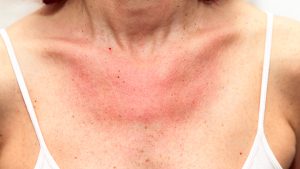Understanding Sun Allergies Sun allergies, also known as photosensitivity, occur when the skin reacts abnormally to sunlight. This condition can lead to uncomfortable symptoms such as itching, redness, and blisters. Understanding the triggers and how to protect your skin is crucial for managing sun allergies effectively. Types of Sun Allergies There are several types of
Understanding Sun Allergies
Sun allergies, also known as photosensitivity, occur when the skin reacts abnormally to sunlight. This condition can lead to uncomfortable symptoms such as itching, redness, and blisters. Understanding the triggers and how to protect your skin is crucial for managing sun allergies effectively.
Types of Sun Allergies
There are several types of sun allergies, each with its own set of symptoms and triggers:
1. Polymorphic Light Eruption (PMLE)
PMLE is one of the most common types of sun allergies. It typically occurs in people who are sensitive to sunlight and can result in itchy or burning skin, redness, and small bumps or blisters.
2. Solar Urticaria
Solar urticaria is characterized by the sudden onset of hives or welts on the skin after exposure to sunlight. These welts can be extremely itchy and may last for several hours.
3. Photoallergic Eruption
Photoallergic eruption occurs when certain substances on the skin react with sunlight, triggering an allergic reaction. Common triggers include fragrances, medications, and skincare products.
4. Actinic Prurigo
Actinic prurigo is a hereditary form of sun allergy that causes itchy, red bumps to appear on sun-exposed areas of the skin. This condition is most common in people of Native American or Hispanic descent.

Image by: yendex.com
Identifying Triggers
Sunscreen Ingredients
Some sunscreen ingredients can actually exacerbate sun allergies in certain individuals. Chemical sunscreens containing oxybenzone, avobenzone, and octocrylene are more likely to cause allergic reactions than physical sunscreens containing zinc oxide or titanium dioxide.
Medications
Certain medications, such as antibiotics, diuretics, and nonsteroidal anti-inflammatory drugs (NSAIDs), can increase sensitivity to sunlight and trigger allergic reactions. It’s important to check with your healthcare provider if you suspect that your medication may be contributing to your sun allergy.
Fragrances and Skincare Products
Fragrances and certain chemicals found in skincare products can also cause photoallergic reactions when exposed to sunlight. Avoiding products containing these ingredients can help reduce the risk of sun allergies.
Diet
Believe it or not, your diet can also play a role in sun allergies. Some foods, such as celery, limes, and parsley, contain compounds that make the skin more sensitive to sunlight. If you notice that your sun allergy symptoms worsen after consuming certain foods, consider eliminating them from your diet or consulting with a healthcare professional for guidance.

Image by: yandex.com
Protecting Your Skin
Wear Protective Clothing
One of the most effective ways to prevent sun allergies is to cover up exposed skin with protective clothing. Opt for lightweight, long-sleeved shirts, pants, and wide-brimmed hats to shield your skin from harmful UV rays. Additionally, consider wearing clothing made from tightly woven fabrics or specially treated with UV-protective coatings for added protection.
Use Sunscreen Wisely
Choose a broad-spectrum sunscreen with an SPF of 30 or higher and apply it generously to all exposed areas of skin. Be sure to apply sunscreen at least 15 minutes before going outside to allow it to fully absorb into the skin. Reapply sunscreen every two hours, especially after swimming, sweating, or toweling off, to ensure continuous protection. Don’t forget to apply sunscreen to often overlooked areas such as the ears, lips, and tops of the feet.
Seek Shade
When spending time outdoors, seek shade whenever possible, especially during peak sunlight hours between 10 a.m. and 4 p.m. Shade provides an extra layer of protection against harmful UV rays and can help reduce your risk of developing sun allergies. If you’re unable to find natural shade, consider bringing along a beach umbrella, canopy, or sunshade to create your own shade wherever you go.
Avoid Tanning Beds
Tanning beds emit UV radiation that can exacerbate sun allergies and increase the risk of skin cancer. Avoid using tanning beds altogether and opt for safer alternatives such as self-tanning lotions or spray tans if you desire a sun-kissed glow. Remember that there is no such thing as a safe tan, and any change in skin color indicates damage from UV radiation.
Stay Hydrated
Proper hydration is essential for maintaining healthy skin and reducing the risk of sun allergies. Drink plenty of water throughout the day to keep your skin hydrated and less prone to irritation from sunlight. In addition to water, consider consuming hydrating foods such as fruits and vegetables with high water content, including watermelon, cucumber, and oranges. Explore More About (Stomach Pain From Stress)

Image by: www.chandleraz.gov
Practice Good Skincare Habits
In addition to sunscreen, incorporating good skincare habits into your daily routine can help protect your skin from sun damage and reduce the risk of developing sun allergies. Wash your face with a gentle cleanser twice daily to remove dirt, oil, and impurities that can clog pores and contribute to skin irritation. Use a moisturizer with built-in sunscreen to hydrate your skin while providing added protection against UV rays.
| Feature | Chemical Sunscreens | Physical Sunscreens |
|---|---|---|
| Active Ingredients | Contains chemicals such as oxybenzone, avobenzone, octocrylene, homosalate, and octinoxate | Contains mineral-based ingredients such as zinc oxide and titanium dioxide |
| Protection | Absorbs UV rays and converts them into heat, releasing it from the skin | Reflects and scatters UV rays away from the skin, forming a physical barrier |
| Allergy Potential | More likely to cause allergic reactions and skin irritation due to chemical ingredients | Less likely to cause allergic reactions and suitable for sensitive skin |
| Application | Typically thinner consistency and easier to apply evenly | Often thicker and may leave a white cast on the skin |
| Environmental Impact | May contain chemicals harmful to marine life if washed off into waterways | Generally considered safer for the environment as they do not contain harmful chemicals |
| Sun Protection Factor (SPF) | Can offer high SPF levels for broad-spectrum protection | May have lower SPF levels but still provide effective sun protection |
| Photostability | May degrade more quickly when exposed to sunlight | More photostable and less likely to degrade over time |
| Ideal Use | Suitable for daily use and under makeup | Ideal for outdoor activities and water sports |
Conclusion
By understanding the triggers and taking proactive steps to protect your skin, you can effectively manage sun allergies and enjoy time outdoors without discomfort. Remember to wear protective clothing, use sunscreen wisely, and avoid known triggers to minimize the risk of allergic reactions. With the right precautions, you can enjoy the sun safely and protect your skin from harm.
















